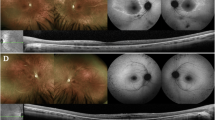Abstract
Next generation sequencing (NGS) technology, with the ability to sequence many genomic regions at once, can provide clinicians with increased information, in the form of more mutations detected. Discussions on broad testing technology have largely been focused on incidental findings, or unanticipated results related to diseases beyond the primary indication for testing. By examining multiple genes that could be responsible for the patient’s presentation, however, there is also the possibility of unexpected results that are related to the reason genetic testing was ordered. We present a case study where multiple potentially causative mutations were detected using NGS technology. This case raises questions of scientific uncertainty, and has important implications for medical management and secondary studies. Clinicians and genetic counselors should be aware of the potential for increased information to affect one’s understanding of genetic risk, and the pre- and post-testing counseling process.

Similar content being viewed by others
References
Allikmets, R. (2007). Stargardt disease: From gene discovery to therapy. In J. Tombran-Tink & C. J. Barnstable (Eds.), Retinal degenerations: Biology, diagnostics and therapeutics (pp. 105–118). Totowa: Humana Press.
Alpert, N. R., Mohiddin, S. A., Tripodi, D., Jacobsen-Hatzell, J., Vaughn-Whitley, K., Brosseau, C., et al. (2005). Molecular and phenotypic effects of heterozygous, homozygous, and compound heterozygote myosin heavy-chain mutations. American Journal of Physiology—Heart and Circulatory Physiology, 288, H1097–H1102.
Branham, K., Othman, M., Brumm, M., Karoukis, A. J., Atmaca-Sonmez, P., Yashar, B. M., et al. (2012). Mutations in RPGR and RP2 account for 15 % of males with simplex retinal degenerative disease. Investigative Ophthalmology & Visual Science, 53(13), 8232–8237. doi:https://doi.org/10.1167/iovs.12-11025.
Churchill, J. D., Bowne, S. J., Sullivan, L. S., Lewis, R. A., Wheaton, D. K., Birch, D. G., et al. (2013). Mutations in the X-linked retinitis pigmentosa genes RPGR and RP2 found in 8.5% of families with a provisional diagnosis of autosomal dominant retinitis pigmentosa. Investigative Ophthalmology & Visual Science, 54(2), 1411–1416. doi:https://doi.org/10.1167/iovs.12-11541.
Fahim, A. T., Bowne, S. J., Sullivan, L. S., Webb, K. D., Williams, J. T., Wheaton, D. K., et al. (2011). Allelic heterogeneity and genetic modifier loci contribute to clinical variation in males with X-linked retinitis pigmentosa due to RPGR mutations. PLOS One, 6(8), E23021. doi:https://doi.org/10.1371/journal.pone.0023021.
Fauser, S., Munz, M., & Besch, D. (2003). Further support for digenic inheritance in Bardet-Biedl syndrome. Journal of Medical Genetics, 40(8), e104.
Girolami, F., Ho, C. Y., Semsarian, C., Baldi, M., Will, M. L., Baldini, K., et al. (2010). Clinical features and outcomes of hypertrophic cardiomyopathy associated with triple sarcomere protein gene mutations. Journal of the American College of Cardiology, 55, 1444–1453.
Hamel, C. P. (2007). Cone rod dystrophies. Orphanet Journal of Rare Diseases. 2(7). doi:https://doi.org/10.1186/1750-1172-2-7
Kajiwara, K., Berson, E. L., & Dryja, T. P. (1994). Digenic retinitis pigmentosa due to mutations at the unlinked peripherin/RDS and ROM1 loci. Science, 264, 1604–1608.
Mandal, M. N., Heckenlively, J. R., Burch, T., Chen, L., Vasireddy, V., Koenekoop, R. K., et al. (2005). Sequencing arrays for screening multiple genes associated with early-onset human retinal degenerations on a high-throughput platform. Investigative Ophthalmology & Visual Science, 46(9), 3355–3362.
McKusick, V. A., & O’Neill, M. J. F. (2011). ATP-binding cassette, subfamily A, member 4; ABCA4. OMIM. Retrieved June 1, 2013, from https://doi.org/omim.org/entry/601691.
McKusick, V. A., & Kelly, J. (2013). Retinitis Pigmentosa GTPase regulator; RPGR. OMIM. Retrieved June 1, 2013, from https://doi.org/omim.org/entry/312610.
Musolino, A., Naldi, N., Michiara, M., Bella, M. A., Zanelli, P., Bortesi, B., et al. (2005). A breast cancer patient from Italy with germline mutations in both the BRCA1 and BRCA2 genes. Breast Cancer Research Treatment, 91(2), 203–205.
Neveling, K., Collin, R. W., Gilissen, C., van Huet, R. A., Visser, L., Kwint, M. P., et al. (2012). Next-generation genetic testing for retinitis pigmentosa. Human Mutation, 33(6), 963–972. doi:https://doi.org/10.1002/humu.22045.
Radu, R. A., Yuan, Q., Hu, J., Peng, J. H., Lloyd, M., Nusinowitz, S., et al. (2008). Accelerated accumulation of lipofuscin pigments in the RPE of a mouse model for ABCA4-mediated retinal dystrophies following Vitamin A supplementation. Investigative Ophthalmology & Visual Science, 49(9), 3821–3829. doi:https://doi.org/10.1167/iovs.07-1470.
Raffan, E., & Semple, R. K. (2011). Next generation sequencing—implications for clinical practice. British Medical Bulletin, 99, 53–71. doi:https://doi.org/10.1093/bmb/ldr029.
Shroyer, N. F., Lewis R. A., & Lupski, J. R. (2000). Complex inheritance of ABCR mutations in Stargardt disease: linkage disequilibrium, complex alleles, and pseudodominance. Human Genetics, 106(2), 244–248
Steffensen, A. Y., Jonson, L., Ejlertsen, B., Gerdes, A. M., Nielsen, F. C., & Hansen, T. V. (2010). Identification of a Danish breast/ovarian cancer family double heterozygote for BRCA1 and BRCA2 mutations. Familial Cancer, 9(3), 283–287. doi:https://doi.org/10.1007/s10689-010-9345-6.
Uhrhammer, N., & Bignon, Y. J. (2008). Report of a family segregating mutations in both the APC and MSH2 genes: juvenile onset of colorectal cancer in a double heterozygote. International Journal of Colorectal Disease, 23(11), 1131–1135. doi:https://doi.org/10.1007/s00384-008-0526-9.
Wolf, S. M., Lawrenz, F. P., Nelson, C. A., Kahn, J. P., Cho, M. K., Clayton, E. W., et al. (2008). Managing incidental findings in human subjects research: analysis and recommendations. The Journal of Law, Medicine & Ethics, 36(2), 219–248. doi:https://doi.org/10.1111/j.1748-720X.2008.00266.x.
Disclosures
Author Kari Branham receives support by the Foundation Fighting Blindness.
Author information
Authors and Affiliations
Corresponding author
Rights and permissions
About this article
Cite this article
Huang, J.T., Heckenlively, J.R., Jayasundera, K.T. et al. The Ophthalmic Experience: Unanticipated Primary Findings in the Era of Next Generation Sequencing. J Genet Counsel 23, 588–593 (2014). https://doi.org/10.1007/s10897-013-9679-y
Received:
Accepted:
Published:
Issue Date:
DOI: https://doi.org/10.1007/s10897-013-9679-y




